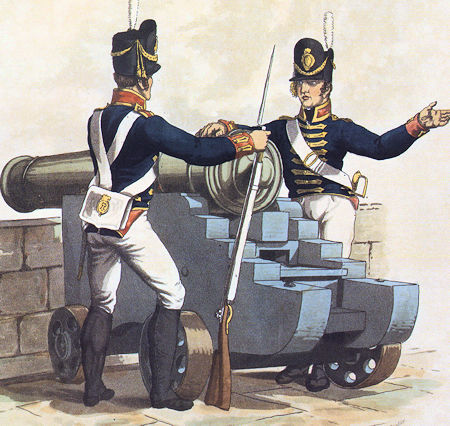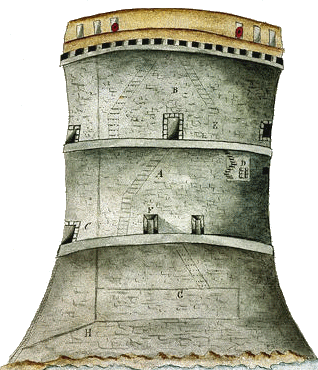British Armed Forces in the 19th Century

The Army, Militia and Volunteers in the Napoleonic Wars
In 1793, shortly before Britain became involved in the French Revolutionary Wars, the army consisted of three regiments of Household Cavalry, 27 line regiments of cavalry, seven battalions in three regiments of Foot Guards and 81 battalions in 77 numbered regiments of line infantry, with two colonial corps (one in New South Wales and one in Canada). There were 36 Independent Companies of Invalids, known by their Captain's name, scattered in garrisons and forts across Great Britain. Administered separately by the Board of Ordnance, the artillery had 40 companies in four battalions of Foot Artillery, 10 companies in the Invalid Battalion, two independent companies in India and a Company of Cadets.
Two troops of the Royal Horse Artillery were being organised. The Corps of Royal Engineers and Invalid Corps of Royal Engineers were specialised bodies of officers. The Corps of Royal Military Artificers consisted of six companies. There were also two Independent Companies of Artificers.

Royal Artillarly c 1810
There was no formal command structure, and a variety of government departments controlled army units depending on where they were stationed; troops in Ireland were controlled by the Irish Establishment, rather than the War Office in London, for example. In 1793, the first steps towards formal organisation were taken when fifteen general officers were appointed to command military districts in England and Wales.
As well as the regular Army, there was another the compulsory service, the Militia, who carried on with their normal occupations unless required for service.
All men aged 28-45 were eligible for the Militia to serve for five years. The men were chosen by ballot in each parish Those chosen could still get out of serving by employing a 'Substitute' and many men made this substitution a profession, offering to serve in various counties every five years. As men from a parish came to the end of their five years of service, a new ballot would be held for his replacement. The men of the Militia might not see any active service in times of peace, but they would be trained, provided with uniform etc and must be ready to be embodied at any time, i.e. to go on active service.
The volunteer force formed in Great Britain during the French Revolutionary and Napoleonic wars was one of the largest movements of any sort during the eighteenth century. It involved numerous and varied armed corps of civilians associated for internal defence in the event of an invasion, which was provided with government allowances and exemptions both from taxes and from compulsory full-time military service. From 1793 till 1815, is considered, the volunteer force played a significant military and political role.
The volunteers comprised several major types of corps: volunteer infantry, yeomanry cavalry, volunteer artillery, and armed associations of infantry or cavalry, and were distinct from the militia, fencibles and regular army. All volunteer corps were organisations of armed civilians, associated with official sanction for the maintenance of internal order and for defence against invasion. Volunteer and yeomanry corps were formed throughout the country from 1794, reaching by 1803 a total of nearly 400,000 men in more than 4600 individual companies, representing possibly around 18% of men of military age.
Volunteers committed themselves to full-time military service in local defence in the event of an invasion or insurrection, but until such an event remained civilians exercising only occasionally. In return, corps were provided with arms and allowances for uniforms, and the exempted from militia service. Volunteer corps were organised throughout the country, with concentrations in southern coastal counties and in Scotland, in some counties involving a third of the adult males. Men of all social levels other than the very poor were involved either actively or as subscribers in what has been characterised as the single largest mass movement of the eighteenth century.
The Fencibles (from the word defencible) were British regiments raised in the United Kingdom and in the colonies for defence against the threat of invasion during the French Revolutionary Wars, the Napoleonic Wars and the War of 1812 in the late 18th and early 19th centuries. Usually temporary units, composed of local recruits and commanded by Regular Army officers, they were usually confined to garrison and patrol duties, freeing Regular Army units to perform offensive operations. Most fencible regiments had no liability for overseas service.
Fencible units were raised in the United Kingdom during the early years of the war. This included not only land regiments but also the Sea Fencibles (raised in 1798 and disbanded in 1810). By the Peace of Amiens in 1802, all Fencible Regiments had been disbanded and those members willing to continue serving had been transferred to regular army regiments, though some Fencibles were raised again to meet the threat of Napoleon's invasion of England in 1803 to 1805
(With thanks to Diane Trenchard for some of the text from her web page at https://www.genuki.org.uk/big/MilitaryHistory/Militia)








 Red Dragon I.T. Ltd.
Red Dragon I.T. Ltd.